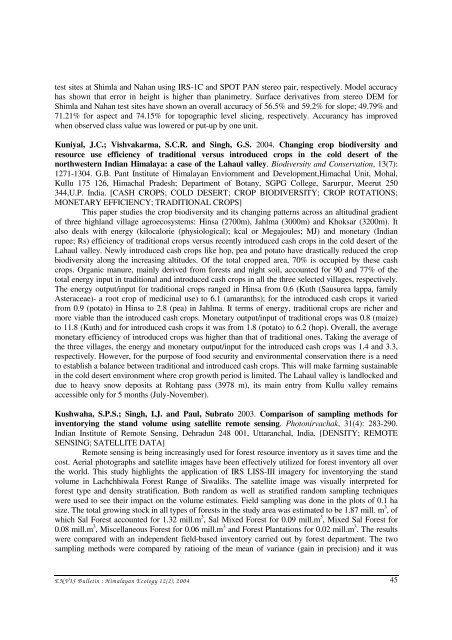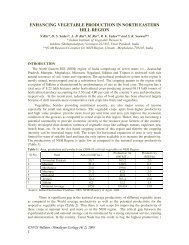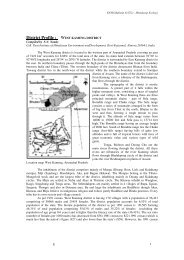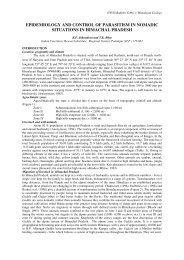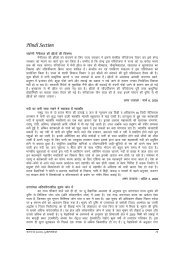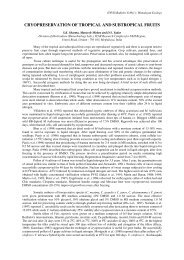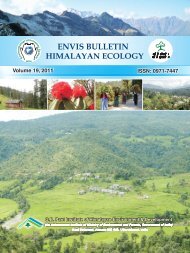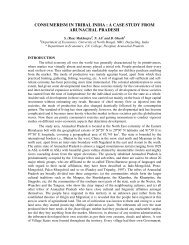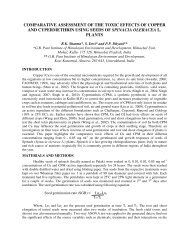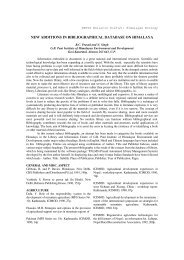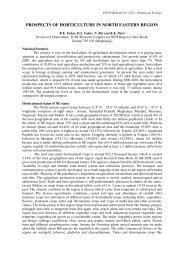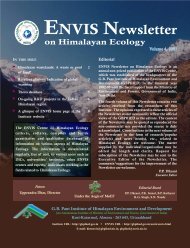The phosphorus load c<strong>on</strong>centrati<strong>on</strong> and its compartmentalizati<strong>on</strong> into various comp<strong>on</strong>ents of theHokersar wetland, and important Kashmir <strong>Himalayan</strong> game reserve, was worked out during the studyperiod (Nov. 2000 - Oct 2001). The data are presented <strong>on</strong> the demographic trends in the catchment ofthe wetland and the phosphorus load as such was assessed. The high phosphorus load in the catchment(30568 kg yr -1 ) is reflected in the high c<strong>on</strong>centrati<strong>on</strong> of phosphorus in the wetland water and othercomp<strong>on</strong>ents. The role of low flushing rate (3.75 times yr -1 ) and high residence time (97.3 days) of waterin the phosphorus cycling has been highlighted. The distributi<strong>on</strong> pattern of this element in suchecosystems helps to understand their behaviour and proves very helpful in formulating their ecorestorati<strong>on</strong>strategies.Khan, Y.; Sharma, R.C. and Sharma, Sanjeev 2004. Incidence and severity of leaf rust(Melampsora ciliata) of poplar in Himachal Pradesh. The Indian Forester, 130(6): 673-679.Department of Mycology and Plant Pathology, Dr. Y.S. Parmar University of Horticulture and Forestry,Solan, Himachal Pradesh. [AGRO-CLIMATIC CONDITION; HIMACHAL PRADESH; SEEDLING]Am<strong>on</strong>g the various poplar nurseries surveyed in Himachal Pradesh, the leaf rust was firstrecorded in the m<strong>on</strong>th of April <strong>on</strong> grown up trees of Populus `Lux' at Nauni. In the Nauni nursery, thedisease appeared <strong>on</strong> P. ciliata seedlings in June. In Shilly nursery, rust was first recorded in July <strong>on</strong> P.ciliata and P. xeuramericana `65/27' seedlings. At Palampur and Bajaura nurseries, disease was firstobserved in August <strong>on</strong> P. ciliata. Disease did not appear at Nalagarh nursery where plants of 27 familiesof P. deltoides were raised. The disease index at Nauni and Shilly nurseries varied between 21.78 to59.14 per cent and 22.85 to 72.75 per cent respectively. At Palampur and Bajaura nurseries, the diseaseindex ranged between 12.06 to 43.46 per cent and 2.05 to 23.00 per cent, respectively. Number of rustfree cl<strong>on</strong>es, families and Populus species were recorded in different locati<strong>on</strong> surveyed.Kotlia, B.S. and Rawat, K.S. 2004. Soft sediment deformati<strong>on</strong> structures in the Garbyangpalaeolake: evidence for the past shaking events in the Kumaun Tethys Himalaya. CurrentScience, 87(3): 377-379. Department of Geology, Kumaun University, Nainital 263 002, Uttaranchal,India. [EARTHQUAKES; KUMAUN HIMALAYA; SEDIMENTS]Soft sediment deformati<strong>on</strong> structures are observed in the laminated sediments and sandy part ofthe 150 m thick palaeolake profile exposed al<strong>on</strong>g the Chhidu Nala near Garbyang village in the Tethysz<strong>on</strong>e of Kumaun Himalaya. The deformed, laminated sediments and sand are separated by gravel. Weobserved both penec<strong>on</strong>temporaneous and post-depositi<strong>on</strong>al deformati<strong>on</strong>al patterns. The deformati<strong>on</strong>may have taken place due to thixotropy and fluidizati<strong>on</strong> causing visco-plastic failure of the mud, anddensity inversi<strong>on</strong> between mud and sand due to liquefacti<strong>on</strong>, was probably triggered by earthquakes.This gave rise to soft sediment folds, dykes, faults, load and pseudo-nodule structures in mud, silt andsand. The study area lies in the seismically active z<strong>on</strong>e of the Kumaun Himalaya.Kumar, Pramod; Kumar, Sudhir and Manchanda, M.L. 2004. Satellite stereo data for demsurfaces and derivatives. Phot<strong>on</strong>irvachak, 32(1): 81-90. Regi<strong>on</strong>al Remote Sensing <str<strong>on</strong>g>Centre</str<strong>on</strong>g>, 4-KalidasRoad, Dehradun 248 001, Uttaranchal, India. [DIGITAL ELEVATION MODEL; PAN DATA;SATELLITE DATA]Various attributes can be derived from Digital Elevati<strong>on</strong> Model (DEM), with are essential toanalyze watershed physical characteristics. This paper discusses utility and accuracy of satellite DEMsurfaces and their derivatives. Facilities available in various software packages were compared togenerate DEM from satellite date and other sources. For test site at Chamba, Uttaranchal, DEMsproduced from various algorithms were evaluated for accuracy of surface and its derivatives. Most of thealgorithms have shown correlati<strong>on</strong> coefficient of 0.99 and above but the desirable maximum error inspot height (1/5 of c<strong>on</strong>tour interval) is not achieved. Slope and aspect produced from various algorithmswere comparable around 70-80%. Comparis<strong>on</strong> of DEM surface and its derivatives were attempted for44E N V IS C entre, G B P IH E D
test sites at Shimla and Nahan using IRS-1C and SPOT PAN stereo pair, respectively. Model accuracyhas shown that error in height is higher than planimetry. Surface derivatives from stereo DEM forShimla and Nahan test sites have shown an overall accuracy of 56.5% and 59.2% for slope; 49.79% and71.21% for aspect and 74.15% for topographic level slicing, respectively. Accurancy has improvedwhen observed class value was lowered or put-up by <strong>on</strong>e unit.Kuniyal, J.C.; Vishvakarma, S.C.R. and Singh, G.S. 2004. Changing crop biodiversity andresource use efficiency of traditi<strong>on</strong>al versus introduced crops in the cold desert of thenorthwestern Indian Himalaya: a case of the Lahaul valley. Biodiversity and C<strong>on</strong>servati<strong>on</strong>, 13(7):1271-1304. G.B. Pant Institute of <strong>Himalayan</strong> Enviornment and Development,Himachal Unit, Mohal,Kullu 175 126, Himachal Pradesh; Department of Botany, SGPG College, Sarurpur, Meerut 250344,U.P. India. [CASH CROPS; COLD DESERT; CROP BIODIVERSITY; CROP ROTATIONS;MONETARY EFFICIENCY; TRADITIONAL CROPS]This paper studies the crop biodiversity and its changing patterns across an altitudinal gradientof three highland village agroecosystems: Hinsa (2700m), Jahlma (3000m) and Khoksar (3200m). Italso deals with energy (kilocalorie (physiological); kcal or Megajoules; MJ) and m<strong>on</strong>etary (Indianrupee; Rs) efficiency of traditi<strong>on</strong>al crops versus recently introduced cash crops in the cold desert of theLahaul valley. Newly introduced cash crops like hop, pea and potato have drastically reduced the cropbiodiversity al<strong>on</strong>g the increasing altitudes. Of the total cropped area, 70% is occupied by these cashcrops. Organic manure, mainly derived from forests and night soil, accounted for 90 and 77% of thetotal energy input in traditi<strong>on</strong>al and introduced cash crops in all the three selected villages, respectively.The energy output/input for traditi<strong>on</strong>al crops ranged in Hinsa from 0.6 (Kuth (Sausurea lappa, familyAsteraceae)- a root crop of medicinal use) to 6.1 (amaranths); for the introduced cash crops it variedfrom 0.9 (potato) in Hinsa to 2.8 (pea) in Jahlma. It terms of energy, traditi<strong>on</strong>al crops are richer andmore viable than the introduced cash crops. M<strong>on</strong>etary output/input of traditi<strong>on</strong>al crops was 0.8 (maize)to 11.8 (Kuth) and for introduced cash crops it was from 1.8 (potato) to 6.2 (hop). Overall, the averagem<strong>on</strong>etary efficiency of introduced crops was higher than that of traditi<strong>on</strong>al <strong>on</strong>es. Taking the average ofthe three villages, the energy and m<strong>on</strong>etary output/input for the introduced cash crops was 1.4 and 3.3,respectively. However, for the purpose of food security and envir<strong>on</strong>mental c<strong>on</strong>servati<strong>on</strong> there is a needto establish a balance between traditi<strong>on</strong>al and introduced cash crops. This will make farming sustainablein the cold desert envir<strong>on</strong>ment where crop growth period is limited. The Lahaul valley is landlocked anddue to heavy snow deposits at Rohtang pass (3978 m), its main entry from Kullu valley remainsaccessible <strong>on</strong>ly for 5 m<strong>on</strong>ths (July-November).Kushwaha, S.P.S.; Singh, I.J. and Paul, Subrato 2003. Comparis<strong>on</strong> of sampling methods forinventorying the stand volume using satellite remote sensing. Phot<strong>on</strong>irvachak, 31(4): 283-290.Indian Institute of Remote Sensing, Dehradun 248 001, Uttaranchal, India. [DENSITY; REMOTESENSING; SATELLITE DATA]Remote sensing is being increasingly used for forest resource inventory as it saves time and thecost. Aerial photographs and satellite images have been effectively utilized for forest inventory all overthe world. This study highlights the applicati<strong>on</strong> of IRS LISS-III imagery for inventorying the standvolume in Lachchhiwala Forest Range of Siwaliks. The satellite image was visually interpreted forforest type and density stratificati<strong>on</strong>. Both random as well as stratified random sampling techniqueswere used to see their impact <strong>on</strong> the volume estimates. Field sampling was d<strong>on</strong>e in the plots of 0.1 hasize. The total growing stock in all types of forests in the study area was estimated to be 1.87 mill. m 3 , ofwhich Sal Forest accounted for 1.32 mill.m 3 , Sal Mixed Forest for 0.09 mill.m 3 , Mixed Sal Forest for0.08 mill.m 3 , Miscellaneous Forest for 0.06 mill.m 3 and Forest Plantati<strong>on</strong>s for 0.02 mill.m 3 . The resultswere compared with an independent field-based inventory carried out by forest department. The twosampling methods were compared by ratioing of the mean of variance (gain in precisi<strong>on</strong>) and it wasE N V IS B ulletin : H im alayan E cology 12(2), 2004 45
- Page 6 and 7: after year (Gosh, 1984). In North E
- Page 8 and 9: Future thrustThe followings are the
- Page 10 and 11: Table 1: State wise area and produc
- Page 12 and 13: Table 2: Performance of tomato vari
- Page 14 and 15: durable, about 5-6 times costlier,
- Page 16 and 17: IS GOAT FARMING A THREAT TO ECOLOGY
- Page 18 and 19: Bank officers’ viewAll the bank o
- Page 20: FOREST FRAGMENTATION : A THREAT TO
- Page 23 and 24: (ii)(iii)(iv)Area insensitive speci
- Page 25 and 26: ability to nest in the matrix area
- Page 27 and 28: Management actionsLand management e
- Page 29 and 30: Laurance, W. F and Bierregaard, Jr.
- Page 31 and 32: Sample surveyThe present study is b
- Page 33 and 34: Agricultural sectorBiomass from agr
- Page 35 and 36: anches, roots and wood chips etc. D
- Page 37 and 38: GoI, 2001. Report of the Working Gr
- Page 39 and 40: over use and misuse of forests but
- Page 41 and 42: has ensured their survival in extre
- Page 43: Kar, A. 2004. Common wild vegetable
- Page 47 and 48: performance for drought tolerance)
- Page 49 and 50: een assigned to different preceding
- Page 51 and 52: of Himalayan Environment and Develo
- Page 53 and 54: (2%). Total protein content varied
- Page 55 and 56: wheat flour slurry) and 'Malera' (p
- Page 57 and 58: Uniyal, V.P. 2004. Butterflies of N
- Page 59 and 60: N ew s & V iew sNumber of leopards
- Page 61 and 62: also discourage them intake thes dr
- Page 63 and 64: and fauna, Sikkim is redited with h
- Page 65 and 66: i{kksa ij v/;;u fd, tk pqds gSA Hkw
- Page 67 and 68: laLFkku caxykSj esa izksQslj fouksn
- Page 69 and 70: aa/kku dh ikjEifjd iztkfr;ksa ds la
- Page 71 and 72: aaQwyksyksaa dh ?kkVh% % ,d izLrkfo
- Page 73: dVku dks viuh ewlyknkj tM+ksa ds dk


